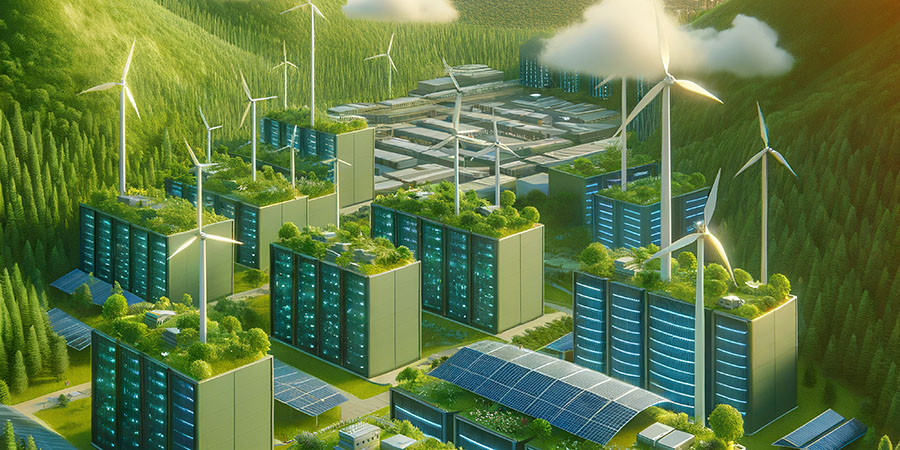Green cloud computing marks a major leap forward in technology, merging cutting-edge cloud technology with eco-friendly practices to foster sustainability and minimize environmental impact. As data centers account for a substantial portion of global electricity consumption and carbon emissions, transitioning to green cloud computing has become a priority for many organizations.
Green cloud computing integrates advanced cloud technologies with sustainable practices to achieve energy efficiency and reduce environmental impact. A key strategy includes server virtualization, which significantly reduces the number of physical servers needed, thus, lowering energy consumption and utility bills. Additionally, the use of renewable energy sources, such as solar and wind power, helps to further diminish the carbon footprint associated with cloud services.
One of the most significant benefits of green cloud computing is its role in promoting sustainable architecture. Data centers designed with minimal environmental impact in mind can operate more efficiently, using less power and generating less waste. This approach also supports remote work, which reduces the carbon emissions linked to commuting. Furthermore, green cloud computing encourages paperless operations, leading to decreased paper use and deforestation, and minimizing electronic waste by reducing the reliance on extensive hardware.
Also Read: Cloud and Edge Computing Transforming Industries in Asia Pacific
Green Cloud Computing Strategies
Transitioning to green cloud computing involves several strategic steps. Organizations should start with a comprehensive assessment of their current IT infrastructure to evaluate their energy consumption and carbon footprint. Setting clear, measurable goals for reducing energy use and increasing the adoption of renewable energy is essential for successful implementation.
For example, Globe Telecom partnered with Red Hat to modernize its IT infrastructure, leveraging open-source technologies to enhance scalability, agility, and efficiency. This move comes as the Asia-Pacific cloud infrastructure market is set to soar, projected to reach USD 593.7 billion by 2032.
Selecting cloud service providers committed to sustainability is a crucial practice. Leveraging server virtualization and adopting energy-efficient computing practices can optimize resource usage. Enhancing data center efficiency and continuously monitoring performance are also vital to ensure that environmental goals are met. Engaging stakeholders and educating them about the importance of green cloud computing can drive effective implementation and foster a culture of sustainability.
Notably, Alibaba Cloud has launched its "Green Data Center” initiative, using renewable energy sources and advanced cooling technology to reduce carbon emissions. Tencent is also focused on building green data centers with AI-driven energy efficiency, particularly through its Tianjin data center, which operates utilizing natural cooling and renewable energy.
Green computing techniques are diverse and leverage energy-efficient hardware designs, renewable energy sources, and methods like data deduplication and network virtualization. These techniques are integral to enhancing sustainability and operational efficiency. For instance, energy-efficient hardware designs reduce power consumption and extend the lifecycle of equipment, while data deduplication minimizes data redundancy and storage needs.
For example, Intel’s Sapphire Rapids processors focus on delivering high performance with lower power consumption, incorporating energy-saving features like dynamic power management. Additionally, AMD’s EPYC processors are designed to maximize performance per watt, making them ideal for cloud and enterprise environments, significantly lowering energy costs.
Innovations in green cloud computing also focus on advanced cooling techniques, which are crucial for maintaining data center efficiency. Strategies such as hot-and-cold aisle containment and liquid cooling systems can significantly reduce the energy required for cooling data centers. Huawei’s FusionServer Pro series optimizes power usage through AI-driven energy management and smart cooling systems, reducing energy consumption in data centers.
Telecom Review Asia Exclusive: “Cloud Computing Empowers Digital Transformation” – Patrick Low, Huawei
Leading Examples and Future Trends
Major cloud providers are making substantial commitments to carbon neutrality. Google aims to achieve net-zero emissions across its entire operations and value chain by 2030, targeting a 50% reduction in its Scope 1, 2, and 3 emissions from a 2019 baseline. The company plans to operate its facilities on 24/7 carbon-free energy and invest in both nature-based and technology-based carbon removal solutions. Google’s approach to climate action involves a science-based strategy and ongoing transparency outlining its progress.
AWS is also dedicated to sustainability and has, thus far, achieved 100% renewable electricity usage seven years ahead of its 2030 goal. The company focuses on maximizing energy efficiency through advanced data center design, cooling innovations, and power management technologies. AWS's infrastructure is reported to be up to 4.1 times more efficient than traditional data centers, with their Graviton4 and Inferentia2 chips contributing to enhanced performance and energy efficiency.
Microsoft has set a bold goal to become carbon negative by 2030 and remove all historical emissions by 2050. Their strategy includes reducing emissions, investing in new carbon removal technologies, and supporting global carbon reduction efforts. Microsoft plans to fund carbon removal technologies, help suppliers cut their carbon footprints, and enhance transparency through annual environmental reports. The company also advocates for supportive public policies and engages employees to drive innovation in carbon reduction.
The future of green cloud computing promises further advancements, with emerging technologies like AI-driven energy management and edge computing. AI can optimize energy use by predicting and adjusting power consumption in real-time, while edge computing reduces the need for data transmission to central servers, thus, lowering energy consumption and latency.
Also Read: The Rise of High Performance Computing in Asia
Long-Term Sustainability
Green cloud computing represents a shift towards balancing technological innovation with environmental responsibility. Given that data centers are major consumers of global electricity and contributors to carbon emissions, adopting sustainable cloud solutions is essential. The integration of energy-efficient practices, renewable energy sources, and advanced cooling techniques can significantly reduce the environmental impact of cloud services.
As organizations and individuals increasingly prioritize environmental responsibility, green cloud computing will be at the forefront of efforts to minimize ecological impact while leveraging the benefits of modern cloud technologies.
Read More: Telco Cloud Orchestration Revolutionizing Connectivity in the Asia Pacific






